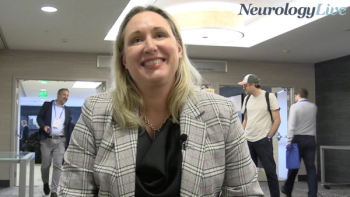
Remyelinating Effects Seen With Cladribine in Relapsing Multiple Sclerosis
The 2-year study highlighted the potential of cladribine to promote remyelination in highly active relapsing-remitting MS, particularly when early disease control is achieved.
Data from a small-scale, open-label study of patients with highly active relapsing-remitting multiple sclerosis (RRMS) revealed that nearly one-fifth of all lesions remyelinated over a 2-year period with cladribine (Mavenclad; EMD Serono), an FDA-approved disease-modifying therapy. Using a q-Space myelin map, the results showed that the effects on remyelination were influenced by the rapid control of disease activity.1
Presented at the
Led by Giordani Rodrigues dos Passos, a researcher at the Pontifical Catholic University of Rio Grande do Sol, in Brazil, participants had 2 relapses in the previous year and an average Expanded Disability Status Scale (EDSS) score of 2.5, and a median of 77 brain lesions at baseline. Over the 2-year period, treatment with oral cladribine resulted in remyelination in 19.2% of the 812 MS lesions, with effects seen mostly within the first year. Overall, there was an inverse correlation between the proportions of remyelinating and demyelinating lesions in the q-Space myelin map (r = –0.729; P = .017).
Remyelination relies on the repair of damaged myelin sheaths, involving microglia cells, oligodendrocyte precursor cells, and mature oligodendrocytes. This process drives the pathophysiology of autoimmune disease of the central nervous system (CNS), MS, leading to nerve cell damage and progressive neurodegeneration. Traditionally, stimulating the reconstruction of damaged myelin sheaths is one of the goals in terms of delaying the progression of MS symptoms and preventing neuronal damage.2
In the study, achievement of No Evidence of Disease Activity (NEDA)-3 status from the start of cladribine treatment resulted in greater odds of remyelination. Specifically, 27.1% of lesions remyelinated in patients who achieved NEDA-3 vs 12.0% of lesions in others who did not (P <.001). A generalized linear mixed model, including subject- and lesion-specific factors, identified NEDA-3 as the only clinical variable predictive of remyelination (P = .007) while lesion location, contrast enhancement and myelin content at baseline were also significant (P <.020). Notably, higher frequencies of regulatory T cells at months 3, 6, and 12 emerged as positive predictors of remyelination (P <.010).1
Cladribine, approved in 2019 for the treatment of adults with relapsing forms of MS, is a synthetic deoxyadenosine (purine) analog classified as an anti-metabolite and anti-pyrimidine agent. Within cells, high cladribine concentrations increase the expression of deoxycytidine kinase (DCK), leading to lymphocyte apoptosis. The phosphorylated form of cladribine disrupts intracellular processes, inhibiting DNA synthesis/repair, ribonucleotide enzymes, and alternating endonuclease activity—low intracellular levels of cladribine increase phosphatase 5’-nucleotidase, which inactivates phosphorylated (active) cladribine.
Earlier this year, at the
In year 1 (Y1), NEDA-3 rate was 32.8% (95% CI, 26.9%-39.4%; n = 229) and NEPAD rate was 32.1% (95% CI, 26.3%-38.6%; n = 229). During year 2 (Y2), NEDA-3 rate was 64.1% (95% CI, 57.2%-70.4%; n = 207) and NEPAD rate was 60.2% (95% CI, 53.3%-66.7%; n = 207). Of note, treatment-naive participants had the highest rates of NEDA-3 (69.1%) and NEPAD (67.85%) at the end of Year 2. Oligoclonal bands (OCBs) were reduced or eliminated at least once at post-BL visits (M12, M24) in 13 of 17 (76.5%) participants. Complete OCBs disappearance was seen in 11.8% (2/17) from BL to M12 and was maintained for one participant (5.9%) to M24.
REFERENCES
1. Rodrigues dos Passos G, Sommer R, Djulia Tesche A, et al. Remyelination in multiple sclerosis lesions after oral cladribine: a 2-year prospective study. Presented at: 2024 ECTRIMS Congress; September 18-20; Copenhagen, Denmark. ABSTRACT P317/2420
2. Maciak K, Dziedzic A, Saluk J. Remyelination in multiple sclerosis from the miRNA perspective. Front Mol Neurosci. 2023;(16). doi:10.3389/fnmol.2023.1199313
3. De Stefano N, Achiron A, Barkhof F, et al. Effect of cladribine tablets on markers of disease progression, axonal loss, and oligoclonal bands in patients with relapsing multiple sclerosis: results from MAGNIFY-MS. Presented at: 2024 CMSC Annual Meeting; May 29-June 2; Nashville, TN. ABSTRACT DMT01
Newsletter
Keep your finger on the pulse of neurology—subscribe to NeurologyLive for expert interviews, new data, and breakthrough treatment updates.




































